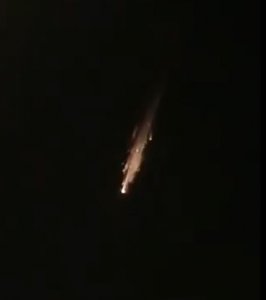Having had a launch setback with its new Long March 7A (CZ-7A) rocket in March, it looked unlikely that China would have another launch failure so soon. And yet, on 9 April 2020, an improved version of its venerable Long March 3B-G2 launch vehicle failed while carrying the Palapa-N1 communications satellite.
An unusually bright transonic vapour cloud was briefly seen during the launch around the time of Max Q. Nevertheless, the flight seemed to go well after its lift-off at 1146 GMT from the Xichang launch site in China’s Sichuan province.
It was later revealed that the vehicle had suffered a third stage failure with the satellite and third stage not achieving orbital velocity, falling back to Earth and re-entering over the Pacific. There were subsequent sightings of re-entering debris from Guam and a supersonic bang was heard.

Debris from the failed Long March 3B launch of Palapa-N1 was seen re-entering over Guam. Courtesy: Weibo
The Palapa-N1 (aka Nusantara Dua) was a communications satellite built by CAST using its DFH-4E bus design, under a “turn-key” construction and delivery-to-orbit contract run by China Great Wall Industry Corp (CGWIC). The satellite was insured for US$252.5 million, with half covered on the world insurance market and the other half retained by the Chinese insurance market. Some of this would have been reinsured internationally.
Comment by David Todd: While this insurance loss is not exceptional, it comes at a difficult time for the space insurance market. Combined with actual and expectedin-orbit claims already likely to total more than US$400 million for this year, losses are now likely to easily outweigh received premiums on a calendar year basis. This is despite an initial rise in premium rates, following the net market loss from last year, which in most cases had yet to come through. Premiums are now likely to be depressed because of launch delays caused by the coronavirus outbreak. With so many launches delayed, China had become virtually “the only game in town”. But after this launch setback, combined with last month’s Long March 7A failure, China is likely to delay further launches until it is sure that its quality control is satisfactory.







